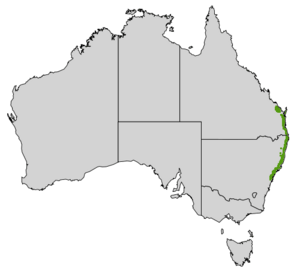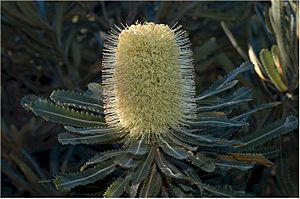Wallum banksia facts for kids
Quick facts for kids Wallum banksia |
|
|---|---|
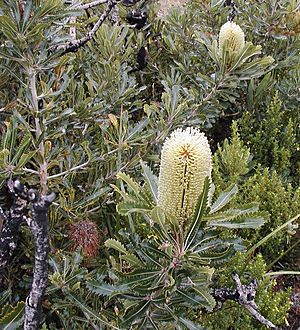 |
|
| B. aemula, Wybung Head – Lake Munmorah |
|
| Scientific classification | |
| Genus: |
Banksia
|
| Species: |
aemula
|
| Synonyms | |
|
|
The Banksia aemula, also known as the wallum banksia, is a type of shrub or small tree. It belongs to the plant family Proteaceae. You can find it along Australia's east coast, from Bundaberg in Queensland all the way south to Sydney.
This plant usually grows in sandy areas near the coast, in a type of heath called Wallum. It can be a shrub or a tree up to 8 m (26 ft) tall. The wallum banksia has special orange, wrinkly bark and shiny green leaves with jagged edges. Its flowers are green-yellow spikes, called inflorescences, which appear in autumn. As the flowers get older, they turn grey, and large grey seed pods, called follicles, grow. After bushfires, the wallum banksia can regrow from its woody base, which is called a lignotuber.
A botanist named Robert Brown first described this plant in the early 1800s. Its scientific name, aemula, means "similar" because it looks a lot like its close relative, Banksia serrata. For many years, it was known by a different name in New South Wales, Banksia serratifolia, but Banksia aemula is now the correct scientific name. Many animals, like mammals, birds, and insects, visit the flowers and help spread pollen. Honeyeater birds are especially common visitors. While it can be grown in gardens, it's not as common as B. serrata.
Contents
What the Wallum Banksia Looks Like
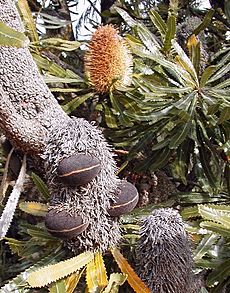
The wallum banksia is usually a twisted shrub or a small tree, growing up to 8 m (26 ft) tall. However, some have been found to be much taller, up to 12.1 m (40 ft) on North Stradbroke Island. Its trunk has thick, orange-brown bark that looks wrinkled and bumpy. New shoots are hairy at first but become smooth as they get older. New leaves grow in spring and summer.
The leaves are shiny green and shaped like an oval, measuring 3–22 cm (1+1⁄4–8+3⁄4 in) long and 1–2 cm (1⁄2–3⁄4 in) wide. Their ends are flat, and their edges are straight and serrated (like a saw).
Flowers and Seeds
The wallum banksia flowers in autumn, from March to June. Its green-yellow flower spikes, called inflorescences, grow at the ends of branches. These spikes are 4 to 20 cm (1+1⁄2 to 8 in) tall and 8 to 9 cm (3+1⁄4 to 3+1⁄2 in) wide. Each spike has between 800 and 1700 tiny flowers. The flowers open one by one, from the bottom of the spike to the top, over one to two weeks. Each flower produces sweet nectar for about seven days after it opens.
As the flower spikes age, they turn grey. Then, up to 25 large, furry grey seed pods (follicles) appear. These pods can be very big, measuring 3–4.5 cm (1+1⁄4–1+3⁄4 in) long. They open up either after a bushfire or on their own, releasing oval seeds. The wallum banksia can regrow from its woody base (lignotuber) after a fire.
How it's Different from Banksia serrata
B. aemula looks very similar to Banksia serrata. But you can tell them apart because B. serrata has greyer bark (not orange-brown) and adult leaves that are wider than 2 cm (3⁄4 in). Also, B. serrata's flowers are usually a duller grey-yellow, and its seed pods are smaller.
Where the Wallum Banksia Grows
The wallum banksia grows along the east coast of Australia. You can find it from about 70 km (43 mi) north of Bundaberg in Queensland down to La Perouse near Botany Bay in Sydney. It also grows on Fraser, Moreton, and North Stradbroke Islands. Most of these plants are found within a few kilometers of the coast.
It mostly grows in deep sandy soils, either on sand dunes or flat areas that might get wet during certain seasons. These areas, with open woodlands or heathlands, are called wallum. In Queensland, it often grows with Banksia robur (which prefers wetter spots) and Banksia oblongifolia.
In some wallum areas, it can grow as a small tree alongside other plants like the red bloodwood (Corymbia gummifera). In Cooloola National Park, it can be found as a taller plant in heathlands. On the New South Wales Central Coast, it's usually a 1–2 m (3+1⁄4–6+1⁄2 ft) tall shrub in coastal heathlands.
In western Sydney, the wallum banksia is part of the Agnes Banks Woodland, which is an endangered plant community. Here, it grows under taller trees like scribbly gum (Eucalyptus sclerophylla) and B. serrata.
Life Cycle and Ecology
Like most Proteaceae plants, Banksia aemula has special roots called proteoid roots. These roots have many short, dense branches that form a mat just under the leaf litter. They are very good at taking in nutrients from poor soils, especially soils that don't have much phosphorus, which is common in Australia. Studies show that wallum banksias are very sensitive to too much phosphorus.
Animal Visitors and Pollination
Many small animals visit the flowers of B. aemula. A study in Bundjalung National Park found that small mammals like yellow-footed antechinus and different types of rodents (like rats and mice) feed on the flowers. These animals carry pollen, helping the plant reproduce. Grey-headed flying foxes also visit the flowers and help with pollination.
Many bird species, especially honeyeaters, also feed on the nectar. These include rainbow lorikeets, scarlet honeyeaters, Lewin's honeyeaters, New Holland honeyeaters, and brown honeyeaters. Insects like ants and bees (including honeybees) have also been seen visiting the flowers.
Surviving Fire
The wallum banksia can regrow from its woody base (lignotuber) or from buds under its bark after a fire. For healthy growth, it's recommended that these areas have fires every 7 to 20 years. Too much phosphorus is harmful to young wallum banksia seedlings, even in small amounts. The seedlings grow slowly at first, which might help them survive in tough environments with little water or nutrients.
The seeds are killed by very high heat (150°C) but can survive temperatures of 100°C for seven minutes. B. aemula seeds can also fall and sprout over time, not just after a fire. Young plants grow well with little harm from animals.
Growing Wallum Banksia
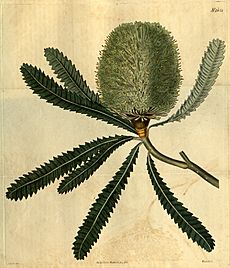
Banksia aemula was one of the first banksias grown in England back in 1788. People like to grow it because of its shiny green leaves, pretty flower spikes, huge seed pods, and interesting wrinkled bark. It also attracts birds and insects to gardens.
This plant needs soil that drains well and is slightly acidic (pH 5.5–6.5), preferably sandy. It also needs a sunny spot. It's a good idea to water it in summer, as it doesn't handle dry conditions very well. The wallum banksia grows slowly and takes about four to six years to flower from seed. It's not as commonly grown as Banksia serrata. For best seed sprouting, warm temperatures are needed, so planting in summer is recommended.
The wallum banksia has also been used as a base plant for grafting other banksia species, like Banksia speciosa. It can also be used for bonsai. Its red, textured wood has been used to make furniture.
Images for kids
See also
 In Spanish: Banksia aemula para niños
In Spanish: Banksia aemula para niños


